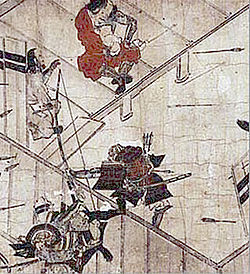- Ashikaga Mochiuji
-
In this Japanese name, the family name is "Ashikaga".
Ashikaga Mochiuji (足利持氏, 1398-1439) was the Kamakura-fu's fourth Kantō kubō during the Sengoku period (15th century) in Japan. During his long and troubled rule the relationship between the west and the east of the country reached an all-time low. Kamakura was finally attacked by shogun Ashikaga Yoshinori and retaken by force. Mochiuji and his eldest son Yoshihisa killed themselves to escape capture.
Contents
Biography
Mochiuji became Kubō while still a child after his father died suddenly of a disease. His violent and abrasive character from the beginning caused widespread resentment among his vassals. After disagreements with Mochiuji, his kanrei Uesugi Zenshū organized a rebellion against him (the so-called Zenshū no Ran) with the aid of nearly half the daimyos in the northern and eastern provinces. Thanks to this support, Zenshū could take Kamakura and Mochiuji had to flee. However, despite his pursuing goals similar to those of the shogunate, Zenshū was after all rebelling against his lord, so the shogunate had no choice but to send troops to stop him. In 1417, Zenshū and his allies found themselves surrounded at Tsurugaoka Hachiman-gū and Zenshū killed himself.
After this took place, Mochiuji attacked Zenshū's allies, which included families as the Oda and the Takeda, along with a few noble families from Musashi province. The Ashikaga themselves thought Mochiuji's actions to be too much, and shogun Ashikaga Yoshinori in 1432 ordered his army to destroy Mochiuji. This led to Mochiuji and Yoshinori to battle it out during the Eikyo Rebellion in 1438. In the end, Yoshinori successfully put an end to Mochiuji's rebellion in 1439. Kamakura's Kubō committed seppuku at the temple of Yōan-ji, west of the city. The events in Kamakura however caused widespread resentment among Yoshinori's generals and one of them, Akamatsu Mitsusuke, murdered him in revenge.[1].
Yōan-ji
The road that in Kamakura turns right before Zuisen-ji's ticket counter leads to a stele marking the spot where Yōan-ji (永安寺) used to stand[2]. It was here that Mochiuji made his last stand against the shogunate, finally disemboweling himself to avoid the shame of being taken prisoner[2] He is buried together with three other kubō in a small cemetery within Zuisen-ji (closed to the public)[2]. The stele reads[3]:
When Kantō Kubō Ashikaga Ujimitsu died on January 11, 1398[4], he was given the posthumous name Yōanji Hekizan Zenkō (永安寺壁山全公). His son Mitsukane built this temple and gave it his father's posthumous name. The temple's oshō Dombo Ushūō was a follower of Musō Soseki. On March 24, 1439[5] Kubō Mochiuji, a descendant of Ujimitsu, fought here against shogun Yoshinori, was defeated and disemboweled himself. The temple was burned and never rebuilt. This is where it stood.
Erected by the Kamakuramachi Seinendan in March 1926There is however also a 3.2 m stone hōtō (宝塔 lit. treasure stupa) traditionally supposed to be his grave also at Betsugan-ji, a former Ashikaga family temple in Ōmachi. On the stupa is carved the date 1439, the year of Mochiuji's death, however the tomb seems stylistically to belong rather to the precedent Kamakura period, and the attribution seems therefore dubious.[6]
Mochiuji's eldest son Yoshihisa, 14 years old at the time, was also forced to kill himself at nearby Hōkoku-ji[7]. His three younger sons however escaped to Nikkō and in 1440 were led by Yūki Ujitomo, head of the Yūki clan, to his castle in Koga, Shimōsa province, and survived[8]. When later his castle was attacked by the shogunate, they escaped. Two, Haruō-maru and Yasuō-maru, were caught and executed[8]. The lone survivor, Mochiuji's fourth child Shigeuji, would later become the last Kantō Kubō.
See also
Preceded by
Ashikaga MitsukaneThe five Kantō Kubō
Ashikaga Mochiuji
1409–1439Succeeded by
Ashikaga ShigeujiNotes
- ^ Ashikaga Yoshinori in "Japan Encyclopedia" by Louis Frédéric, Käthe Roth, Google Books, accessed on August 4, 2006
- ^ a b c Kamiya (2008:98-102)
- ^ Original Japanese text available here
- ^ Gregorian date obtained directly from the original Nengō (Ōei 5, 4th day of the 11th month) using Nengocalc
- ^ Gregorian date obtained directly from the original Nengō (Eikyō 11, 10th day of the 2nd month) using Nengocalc
- ^ Omachi by the Kamakura Citizen's Net, accessed on July 17, 2009
- ^ History of Kamakura (3) - Ashikaga Era, Kamakura Today, accessed on July 25, 2009
- ^ a b Papinot (1972:37-38)
References
- Kamiya, Michinori (2008) (in Japanese). Fukaku Aruku - Kamakura Shiseki Sansaku Vol. 1 & 2. Kamakura: Kamakura Shunshūsha. ISBN 4774003409. OCLC 169992721.
- Papinot, E. (1910). "Historical and Geographical Dictionary of Japan." 1972 Printing. Charles E. Tuttle Company, Tokyo, ISBN 0-8048-0996-8.
- Sansom, George (January 1, 1977). A History of Japan (3-volume boxed set). Vol. 2 (2000 ed.). Charles E. Tuttle Co.. ISBN 4-8053-0375-1.
Categories:- 1398 births
- 1439 deaths
- Kantō kubō
- Ashikaga clan
Wikimedia Foundation. 2010.


